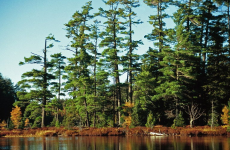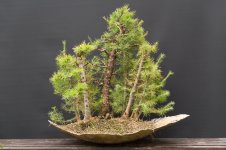Lots of good ideas from folks, sift through these to make your forest as you desire.
A couple things to point out…. The question is whether one wants to make a natural looking bonsai, or go abstract.
Don’t know how eastern larches grow for in nature although I have seen a lot of images, for example. Note straight up…
View attachment 569376
My experience is 1000’s of hours hiking amongst Western Larches, Redwoods, Firs, Spruces, Hemlocks etc. in the Western states and Alaska.
In nature 99.9% of the trees are razor straight unless they have been knocked over. Occasionally they may be pistol butted, yet not as much as many other trees. Also the old forest giant larches often get their tops knocked off by lightening strikes and windstorms, being as they are above the canopy. Then they broom up, sort like a redwood does.
Here’s an image of a western Larches forest setting. Note razor straight. Same on a slope.
View attachment 569383
Note how these trees don’t have the classic Japanese confir style with every one of the branches going down?
Anyway the point is making a larch forest with “trunk movement” wouldn’t look natural, at least to me. But if one wants to take artist license and make the trees in a Classical Japanese style.
The real difference in larches forests is the branches themselves, especially the older trees in the open. The trunks basically grow up, unsleeping they have been knocked around in storms, snow pressure and avalanches. Then the trunks go back up for that point. The branches are a different story, helter skelter, missing here, short there, long here, and clustered in certain areas…mostly the top.
No matter if one makes a forest of groups, or of individual trees of different ages, imho the amount of work done is pretty much the same. No matter, it’s basically clip and grow. However letting the trees grow together can actually save one time as the trees natural interaction will help create more natural image.
Btw, The Ezo forest was patterned using Saburo Kato’s method. Mr Kato was a highly respected Japanese master who specialized in forest plantings.
Good luck on your project.
Cheers
DSD sends









![image4[4209].jpg](/data/attachments/558/558916-3b8159df2bd3a2613b94fb836c09ee6b.jpg?hash=HKJPeI56-c)

